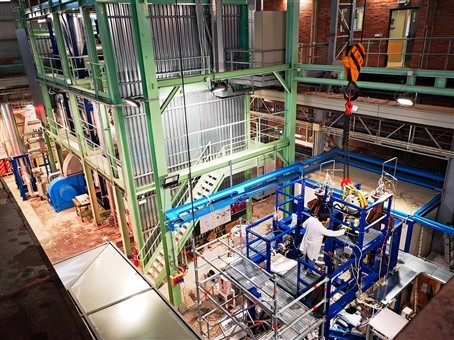F4E and EFLs test TBM technology and equipment

Experimental activities being carried out in EFLs in order to test TBM technology.
Tritium and deuterium are two isotopes of hydrogen that will be used to fuel the fusion reaction in ITER. While deuterium can be extracted from seawater in virtually boundless quantities, the supply of available tritium is limited, estimated currently at twenty kilos. Consequently, future fusion machines will need to ensure by themselves the ability to self-produce tritium in order to produce electricity.
One of ITER’s missions is to test Tritium Breeder Blanket concepts which will be used in future fusion power machines such as DEMO, for which tritium self-suficiency (i.e. the amount of tritium consumed must be generated by the machine itself) is a requirement.
F4E is currently developing, in collaboration with EUROfusion, two different mock-ups of Tritium Breeder Blankets, called Test Blanket Modules (TBM), to be tested in ITER in a real fusion environment. These are: the HCPB (Helium Cooled Pebble Bed) with lithiated ceramic pebbles as tritium breeder and beryllium pebbles as neutron multiplier, and the WCLL (Water Cooled Lead Lithium) which uses lead-lithium liquid metal as both tritium breeder and neutron multiplier.
Several TBM candidate technologies are being currently tested in dedicated facilities of the European Fusion Laboratories (EFLs) in order to demonstrate their performance and reliability. For example, F4E has been working with KIT and ENEA in order to test two turbo-circulators manufactured by ATEKO for the Helium Cooling System (HCS). The turbo-circulators will circulate helium gas in order to cool down the HCPB-TBM from temperatures of around 500°C to 300°C. The testing has preliminarily demonstrated the capacity of the turbo-circulators to deliver the required helium mass flow rate of around 1.0 kg/s with a pressure of 8 Mpa. The tests have been carried out satisfactorily in a wide range of TBS operating conditions, allowing to validate their stability of operation under several transient and abnormal situations.
Tritium extraction technologies based on liquid metals have also been tested. In particular, the WCLL-TBM makes use of a liquid metal alloy made up of lead and lithium (Pb-Li) that flows inside the TBM to generate tritium. This liquid metal alloy is very corrosive and must be kept above 235°C (its melting point) to circulate adequately inside the lead-lithium circuit.
Key components of the lead-lithium circuit have also been tested. The first component is the cold-trap which eliminates corrosion products in the liquid metal generated during its flow and which could with time become radioactive. F4E, together with CvREZ, have preliminarily demonstrated the efficiency of a new design of air-cooled cold-trap for removing the corrosion particles produced in the lead-lithium loop of the WCLL-TBM.
Together with ENEA Brasimone, F4E has tested advanced technologies for sensors that will be placed in the lead-lithium circuit to monitor and control key parameters such as: temperature, pressure and tritium concentration in the lead-lithium liquid metal. The main challenge in operating such sensors is the compatiblity with the high lead-lithium corrosive environment.
Instrumentation compatibility with lead-lithium has been checked. For example, testing has focussed on sensors which will measure the hydraulic pressure of lead-lithium. Other innovative sensors measuring hydrogen isotopes concentration in lead-lithium liquid metal, based on permeation capsules, still need further investigation for enhancement of their response time and stability.
The last component in the lead-lithium circuit that still needs to be tested is the Tritium Extraction Unit (TEU), whose main function is to extract tritium from the flowing lead-lithium liquid metal. This component will be tested in a facility that it is being upgraded at ENEA Brasimone called TRIEX-II, and is expected to be up and running before summer 2019.